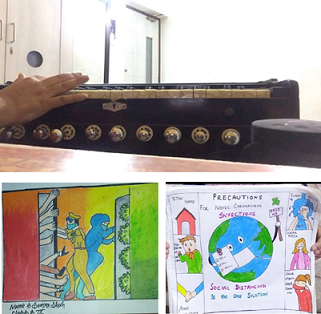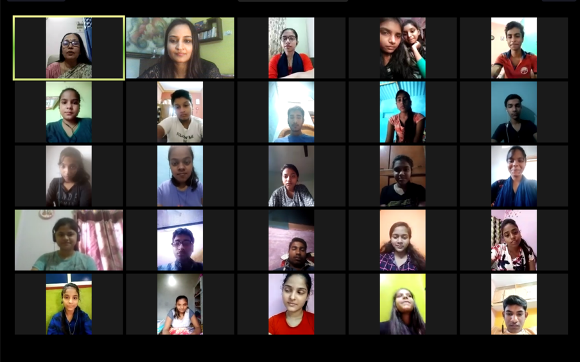10 Ways I Helped My Parents’ School In Remote Bihar Go From Zero Tech to 100% Online
“Thirty years ago, my parents started the school with the motto 'Come to Learn. Go to Serve'. I’m optimistic that these efforts will help over a thousand children to go to serve humanity tomorrow.”

Ever since I was a child, I saw my parents exhibit two inspiring qualities – care and perseverance. While caring shows who we are, being perseverant shows how much we care.
For the past 30 years, my parents have been running Rosy Child School, a primary school in Darbhanga, a remote town on the Indo-Nepal border in Bihar. The school catered to children from nursery to Class 10 and was established to address the lack of good educational institutions in town. Emphasis has therefore been given to extra-curricular activities along with academics.
Despite COVID-19, the urban school system is still functional due to access to technology. Students in rural areas, with a greater need for education, are now lagging due to the lack of technical knowledge and infrastructure. With focused efforts, we can bridge this gap.
By providing access to primary, middle and high-school education for thousands of children, the school has played an arterial role in nation-building. It has produced engineers, chartered accountants, doctors, members of Indian Air Force, public sector employees, actors, flight attendants and business professionals.
The impact of COVID-19 on the school system

When the pandemic struck, it brought turbulent times. The Indian school system was juggling between the Coronavirus threat, Government directives regarding schools, and the methods of continuing education for children. Concern for children’s safety and security in the light of the pandemic prompted schools to adopt various measures. Institutions remain closed until further notice, and the big question is how to keep education going.
There seemed to be an expanding gap between urban and rural education. While urban schools and children are better equipped with technology and getting ahead in their learning, rural areas, where the need for education is higher, are now lagging, due to the lack of technical knowledge and skills.
For instance, in my parents’ school, all communication from the school was handed to students in the form of hard copies. Even report cards were handed physically; the school fee was never collected electronically; the school records were being maintained in a very structured way, but all on paper. In a nutshell, it was the old-school way of schooling.
From Old School to Online School

In a school where technology usage is extremely limited, and any form of online communication was non-existent, there was a sudden and urgent need to turn virtual! While this seems challenging, even in technologically-advanced schools, we needed to bridge the gap between the classroom and online learning.
Locked in my Mumbai home, 1,200 miles away and passionate for technology, this was my golden opportunity to play a part in helping the children of my hometown. I give my parents enormous credit for being willing to allow the adoption of technology in the school. I was both excited and anxious when I started my due diligence of various technology tools and laid down protocols to eventually implement the online learning platform, an extremely rewarding experience.
While going online, several aspects of the school system needed to be considered.
Converting Challenges to Opportunities

1. PEOPLE
a) Technology Training
Problem: There was limited or no understanding of technology among several students, teachers, and parents.
Solution: For onboarding – I wrote e-circulars with step-by-step instructions and screenshots as guidelines for online classes. Tech support was also provided through phone calls to explain the tools and processes.
For seamless implementation and smooth experience for all participants, in all video calls for the first month, the non-academic part was handled by me. Teachers and students entered the online class as participants and focused only on the subject rather than worrying about technical interruptions, taking attendance, monitoring each student for compliance etc.
Having another individual to manage the non-academic part on every call was an important success factor. Once we had a month of stability where students and teachers were comfortable with the system, I identified the three most tech-savvy teachers as champions and took an online training session for them to hand over online administration.
From the second month, the champion teachers handled all classes themselves, with very less dependency on me.
b) Younger Students
Problem: Lack of good command of the English Language. Complicated instructions on technology usage given in English would be tough to understand.
Solution: Voice messages were recorded in English and Hindi for all complicated communications to enable better understanding.
Problem: 99 per cent of the students did not have a laptop and were attending classes through smartphones. Therefore, prolonged staring at a small phone screen would have long-term health issues, especially for younger students.
Solution: Teaching was done in the form of short videos, instead of hours of real-time classes. Videos created by teachers were sent every morning on the class WhatsApp groups. This enabled students to watch and attend classes at their own pace.
c) Extracurricular Skills
Problem: Since the school focuses on extracurricular activities, it was essential to keep that going for an online classroom experience.
Solution: We initiated and had online classes for music, art etc. Regular online competitions on creative writing, art, photography, debate etc. have also kept enthusiasm, creativity and interest in online learning alive.
2. PROCESS
a) Record Keeping:
Problem: Difficulty in connecting to all students. We found that contact details of several parents were not updated. Moreover, since the school did not contact parents on phones, their numbers were not updated since the initial admission of the student.
Solution: We had the staff call every number in the school records and confirm them. We got WhatsApp groups created for each class and crowd sourced the contact details of those missing from the records. Everything was then stored digitally on Microsoft Excel.
b) Assignments
Problem: To manage assignments online. Assignment/homework and evaluation of the same is an integral part of education. Not only is it essential for academic revision but is also a parameter to evaluate the student’s progress in a subject.
Solution for senior classes: I formalised the process via email. School email addresses were created for each class, accessed by the respective teachers, where students could submit their homework.
Solution for junior classes: I formalised the process via WhatsApp. Assignments were sent with the subject video lesson every morning on the class Whatsapp group. Students submitted their assignments and got the checked sheets back on the group the same day.
c.) Evaluation
Problem: Unit tests are a regular feature in schools, and we needed to have one after a month of classes.
Solution: I decided on Google Forms for unit tests since they simplified the process. Results were automatically computed and displayed back to the students immediately upon submission. Our technical setup also allowed cameras to be enabled with the video conferencing app while students took their tests. This was an almost perfect simulation of a real-world evaluation despite distributed technical products.
Problem: Lack of technical knowledge among teachers to understand online evaluations.
Solution: I converted all tests created by teachers into Google Forms for a seamless first-time experience. It was monotonous work, but with the lack of a technical workforce, it had to be done single-handedly. For the second round, I trained our identified champion teachers to create tests forms and handle the evaluation process independently.
Problem: Lack of technical knowledge, especially among younger children, to understand digital evaluation.
Solution: For senior classes, I gave a training session with a sample test form for students to get an understanding of the new way of assessment.
For junior classes, at the assigned time, test questions were sent on the class WhatsApp group. Students wrote their answers on a sheet of paper, took pictures and sent them to the group at the time of submission.
For the next round of tests, even junior classes will use Google Forms. Their familiarity with technology makes us confident in teaching them newer tools.
d) Feedback
Problem: Student/teacher feedback has always been an integral part of this school culture. The principal’s office has always been open for student/teacher walk-ins for any problems/feedback discussion.
Solution: We started regular video meetings on weekends of students with the Principal. This helped understand any issues they might be facing about the online learning infrastructure, the pace of a particular class etc. Private phone number of the Principal was also shared, and students were encouraged to call anytime with any concerns.
This was a new way of teaching for teachers as well. So, we had regular one-on-one calls with them, to understand their problems and formalise the best way of doing things. There was initial nervousness but the excitement of learning new technologies and helping their students stay connected with education in the pandemic, far exceeded the fear of the unknown.
3. INFRASTRUCTURE
a) Network Infrastructure
Problem: There is very limited bandwidth in small towns. Most students and teachers do not have WIFI and are dependent on mobile data.
Solution: I did a week-long due diligence of all stable video conferencing and communication solutions. I installed and evaluated Cisco WebEx, Microsoft Teams, Google Classroom, and Zoom to come up with the best match. The main criteria for our situation were low bandwidth and a small learning curve. We adhered to the best practices for video conferencing implementation, such as proper checks of participants before being allowed on the meeting, and IDs and passwords being frequently changed to enable security.
It is working seamlessly for us even with the usage of mobile data. Occasionally, people do experience patchy network from some service providers.
The table below gives an understanding of the technical evaluation.

b) Tech Support
Problem: Point of contact for technical support is essential for seamless adoption of new technology.
Solution: The biggest limitation was the absence of technical personnel. I knew it was time for me to leverage my technical background to deal with a wide range of technical challenges and handle a large number of phone calls. While I had to provide support during the first two months, I could bring our staff up to speed to share the load from the third month onward.
A teacher says, “I did not think that online education would happen for us and that too so quickly and easily. Our school believed in the old school way of learning and had kept technology away from education. I was explained technology in a very simple and easy way so I am able to understand and manage the classes now. To explain and talk about it on a phone was a challenge in the beginning, but I am getting used to it. I like the mute feature where all students can be made to keep quiet by a button click, I wish I could do it in my regular class too. We are happy that children are not left behind and are connected with education. We are also receiving appreciation from students and parents.”
c) Access to Devices
Problem: Most households had a single handheld device but multiple students. Therefore, it was a challenge to have all students attend classes at the same time.
Solution: I created the school time table such that one class had an online class at any given time. We moved important subjects to online live classes, while the more subjective ones were taught through videos made by teachers and shared online.
So, while younger students until class 5 received their study material in the form of videos made by their teachers on WhatsApp groups, the older ones attended live video classes. This made it easier for each group to access their different subjects and classes, and for us to manage the overall timetable.
Problem: Affordability limitations of Students – No smart device in many households
Awaiting a Solution: Approximately 10 per cent of students are not connected due to lack of smartphones. This is a problem we are working on fixing. We are considering a scholarship programme through which sponsors can donate smartphones to students and help onboard them with online education.
Problem: As the COVID-19 lockdown is easing, it is getting difficult for many working parents to leave their only mobile phone at home for their children and not take it to their workplace.
Awaiting a Solution: Around 15 per cent of students who were connected are missing out on classes since lockdown has eased. We are working on fixing it the same way through the scholarship programme.
Onward to a new way of learning

The outcome of all the work is a seamless online learning system with the simplest, lightest, and most effective platforms. While the current set up has been working well, I plan to establish a unified platform to serve our online schooling needs.
With the experience gained over the past few months, both students and teachers are now better equipped at handling technology. We are also in the process of new technology adoption and are ready to enjoy some learning curve.
The enthusiasm of students and teachers during this time was overwhelming and inspiring.
A student shares, “I was very excited when online classes started as we would learn and get to use new technologies and continue our studies during lockdown. We had problems sometimes because we shared the phone with our parents. I miss going to school and meeting my friends, and playing in the games period. I want to go back to school soon.”
Thirty years ago, my parents started the school with the motto “Come to Learn. Go to Serve”. I’m optimistic that these efforts will help over a thousand children who can come to learn virtually today and go to serve humanity tomorrow. I am honoured to play a part in their journey.
Cover image for representation only.
(Written by Payal Bahadur and Edited by Shruti Singhal)
This story made me
- 97
- 121
- 89
- 167
Tell Us More
We bring stories straight from the heart of India, to inspire millions and create a wave of impact. Our positive movement is growing bigger everyday, and we would love for you to join it.
Please contribute whatever you can, every little penny helps our team in bringing you more stories that support dreams and spread hope.



















